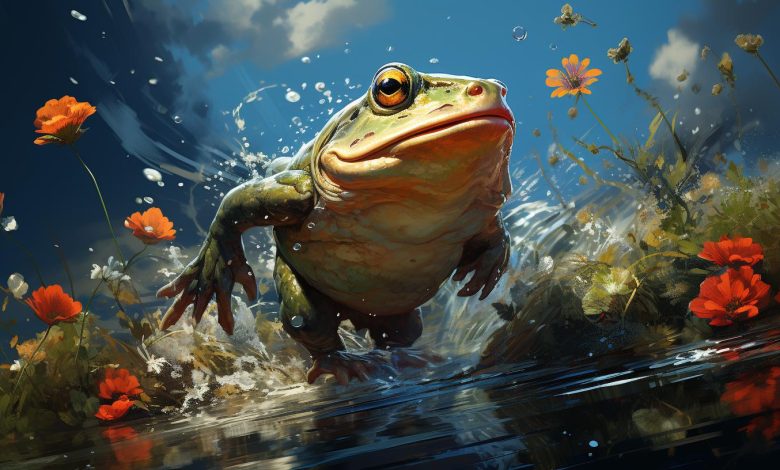Topwater Frog Fishing: Techniques For Explosive Strikes

You’re standing waist-deep in the murky water, the sun beating down on your face. You’ve already cast your line a few times without any bites, but you know that patience is key when it comes to topwater frog fishing.
Did you know that according to a survey conducted by the American Sportfishing Association, bass fishing is the second most popular type of fishing in America? And within bass fishing, topwater frog fishing has become increasingly popular due to its excitement and explosive strikes.
If you’re looking for a heart-pounding experience on the water, then topwater frog fishing might just be for you. But it’s not as simple as throwing out a lure and waiting for a fish to bite. It requires knowledge of different types of frog lures, choosing the right one for your specific situation, presentation techniques, retrieval techniques, and more.
In this article, we’ll dive into these topics so that you can maximize your chances of success and reel in some big catches.
Understanding the Different Types of Frog Lures
Now, let’s get into the nitty-gritty of the various types of lures you can use to entice those big ol’ bass to chomp down on your bait.
When it comes to topwater frog fishing, there are two main types of lures: hollow body and solid body.
Hollow body frogs are made from soft plastic and have a hollow interior that collapses when a fish bites down on it, exposing the hook for an easier hookset. Some popular brands of hollow body frogs include Spro Dean Rojas Bronzeye Frog, Strike King KVD Sexy Frog, and Booyah Pad Crasher.
On the other hand, solid body frogs are typically made from harder materials such as hard plastic or wood and do not collapse when bitten by a fish. This makes them more durable than their hollow-bodied counterparts but also requires a stronger hookset since the hook is often hidden inside the lure. A few popular brands of solid body frogs include Livetarget Hollow Body Frog and Lunkerhunt Phantom Spider.
When choosing your frog lure, color selection can also play a role in attracting more bites depending on water conditions and what type of prey is available for bass to feed on. Consider materials used and durability factors when selecting your frog lure so that you can catch more fish without having to constantly replace your lures due to wear and tear.
With that said, choosing the right frog lure is crucial for ensuring explosive strikes during topwater frog fishing.
Choosing the Right Frog Lure
To pick the perfect frog lure, you’ll want to consider factors like color, size, and style.
When it comes to color selection, it’s important to match the hue of your lure with the water conditions you’re fishing in. For example, if you’re fishing in murky or stained waters, a bright-colored frog may be easier for fish to see. On the other hand, if you’re fishing in clear waters, a more natural or muted color may be more effective.
Other factors to consider when choosing a frog lure include the size of the baitfish in your area and the type of cover you’ll be fishing in. Larger frog lures can mimic bigger baitfish and draw strikes from larger predators while smaller lures can entice more cautious fish. Additionally, certain styles of frog lures may work better than others depending on how they move through vegetation or how they sit on top of the water.
When it comes to topwater frog fishing techniques, presentation is key.
Presentation Techniques
Get ready to watch the water erupt with action as you master the art of presenting your frog lure in a way that brings it to life. Body language and vocal tone are key elements in engaging the audience and telling a story through your presentation.
When casting out, try using a slow, steady retrieve while twitching your rod tip to create a realistic swimming motion for the frog. Pay attention to any obstacles or structure in the water where fish may be hiding and adjust your presentation accordingly.
Another effective technique is pausing your retrieve momentarily to imitate a real frog resting on the surface before continuing with subtle movements. You can also add variation by creating more commotion with louder pops or splashes if you need to grab their attention or when fishing in choppy waters.
Remember that each fish has its own preference, so don’t be afraid to experiment with different techniques until you find what works best. Now that you’ve mastered presentation techniques, let’s move onto retrieval techniques for even more explosive strikes!
Retrieval Techniques
Let’s dive into how to bring your lure to life and entice those fish with smooth, rhythmic movements that mimic a real frog swimming through the water. Retrieval techniques are crucial in topwater frog fishing as they can make or break your chances of getting explosive strikes. Here are some tips on how to retrieve your lure effectively:
– Upstream vs downstream: When fishing in flowing waters, it’s important to consider whether you’re casting upstream or downstream. Casting upstream and retrieving at a slow pace can create a natural-looking movement that mimics a frog swimming against the current. On the other hand, casting downstream and retrieving at a faster pace can imitate a fleeing frog trying to escape predators.
– Slow vs fast retrieval: Experimenting with different retrieval speeds is key because frogs don’t swim at one consistent speed. Try starting with slow, steady retrieves and gradually increase your speed until you find what works best for the day. You can also try pausing every few seconds during your retrieve, simulating a resting or feeding frog.
– Twitches and pops: Adding quick twitches or pops during your retrieve can create sudden movements that catch the attention of nearby fish. Try twitching your rod tip while reeling in slowly or popping it up quickly before letting it fall back down.
– Pause-and-go: Sometimes slowing down or stopping completely during your retrieve can be just what you need to trigger a strike from an actively feeding fish. Try pausing for 5-10 seconds after each movement before continuing with another twitch, pop, or steady retrieve.
– Varying depths: Don’t be afraid to experiment with different depths when retrieving your lure – sometimes fish will be more interested in surface-level frogs while other times they’ll only bite deeper diving ones.
By mastering these retrieval techniques, you’ll be well on your way towards catching more topwater bass using frogs!
Now let’s move onto some tips for maximizing your success.
Tips for Maximizing Your Success
You’ll be amazed at the difference these simple tips can make in your success rate, giving you the satisfaction of reeling in a trophy catch. First and foremost, consider seasonal considerations when choosing your frog lure. During warmer months, opt for bright colored lures that imitate natural prey such as frogs or insects. In colder weather, switch to darker colors to mimic dying prey.
Another way to improve your chances of landing a big one is by modifying your frog lures. Experiment with adding scent or flavor to attract curious fish and increase their likelihood of biting. Additionally, try trimming the legs or tail of your lure to create a more realistic action in the water. By making these small adjustments, you’ll give yourself an edge on the competition and increase your chances of having explosive strikes while topwater frog fishing.
| Emotion | Keyword | ||
|---|---|---|---|
| Excitement | Topwater Frog Fishing | ||
| Satisfaction | Trophy Catch | ||
| Curiosity | Modifying Lures | ||
| Confidence | Seasonal Considerations | ||
| Creativity | Trimming Legs/Tail | Persistence | Practicing Retrieval Techniques |
Conclusion
Congratulations! You now have a solid understanding of topwater frog fishing techniques that will help you catch more fish and experience explosive strikes.
Remember, choosing the right frog lure is crucial to your success. Consider the type of water you’ll be fishing in, as well as the size and color of the frogs in that area.
When it comes to presentation techniques, try using a stop-and-go retrieve or a steady retrieve with occasional pauses. Experiment with different speeds and movements until you find what works best for you.
And don’t forget about retrieval techniques – try walking the frog across lily pads or reeling it through weed beds for added realism.
One example of how these techniques can lead to success is when I was fishing in a heavily weeded area using a green pumpkin-colored frog lure. I used a stop-and-go retrieve technique and paused just long enough for the bass to strike.
Within minutes, I had caught three large bass weighing over five pounds each! With practice and patience, you too can experience similar results.
Happy fishing!


